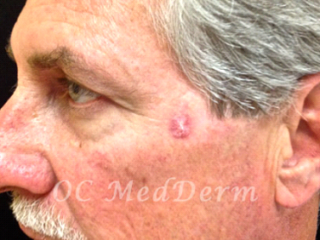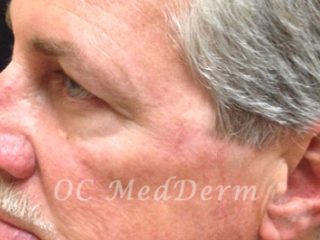Non-melanoma Skin Cancers
Dr. Parvin Shafa a dermatologist in Irvine, Orange County CA is an experienced doctor in diagnosing and treating different types of non-melanoma skin cancers including Basal Cell Carcinoma (BCC) and Squamous Cell Carcinoma (SCC). If you have a skin lesion that is changing, bleeding, growing, or not healing, just call us to make an appointment for a skin evaluation.
Diagnosis and early cancer treatment is easy most of the time. Dr. Shafa is able to diagnose most skin cancers with the naked eye or with a dermoscope. If a skin lesion is suspicious, performing a skin biopsy is quick and effortless with minimal scarring, if any. Using anesthesia also allows the procedure to be pain-free. We are contracted with all types of PPO insurances, including Medicare. Ask questions or call us to make an appointment for a skin check.


What is a basal cell carcinoma (BCC)?

Basal cell carcinoma (BCC) is the most common non-melanoma skin cancer. The lesion usually appears as a bleeding or scabbing sore that heals and returns. When left untreated, BCC can destroy the entire side of the face or eventually penetrate into the bone and brain. If you have a non-healing lesion of this type, it is imperative that you see a physician for evaluation and treatment.
What is a squamous cell carcinoma SCC?

Squamous cell carcinoma (SCC) is an aggressive skin cancer that is characterized by nodules and/or red, scaly patches that may form on sun-exposed skin (i.e. the ears, face, lips, and mouth). Although light and/or fair-skinned people are most prone to developing squamous cell carcinoma, people of all skin types must take precautions to limit sun exposure and get screened for any abnormal skin issues.
Before and After Skin Cancer Removal


This is an actual patient of Dr. Parvin Shafa who was diagnosed with an SCC. Dr. Shafa removed the lesion completely with minimal discomfort and scar.
Basal Cell Carcinoma vs Squamous Cell Carcinoma Differences
- Location
BCC is usually found on the face, head, and neck; location does not consistently correspond with areas of maximum sun exposure, unlike SCC. One third of BCC are found in areas that receive little to no exposure to UV light. SCC is usually found on the head, neck, and other areas that are most frequently exposed to the sun
- Skin color
Patients who have fair complexions are at high risk for SCC with no significant increased risk of BCC
- Risk Factors
Inability to tan is the highest risk factor for BCC. Old age and sun exposure over a lifetime are the highest risk factors for SCC
Squamous Cell Carcinoma v. Basal Cell Carcinoma Similarities
- Age of onset
Both BCC and SCC are more prevalent in middle-aged or older patients
- Risk of Recurrence
Having previously been diagnosed with a BCC or SCC increases your chances of being diagnosed with another of the same type of lesion
- Family History
Having a member of your immediate family diagnosed with either BCC or SCC increases your chance of having the same type of lesion
Ask questions or Call us to make an appointment for your full skin check or evaluation of the skin lesion you are concerned about. We are contracted with all PPO insurances and Medicare.
Other Treatments
Skin Cancer Overview | Melanoma – Skin Cancer | Internal Cancers with Skin Manifestations
Schedule a Consultation
